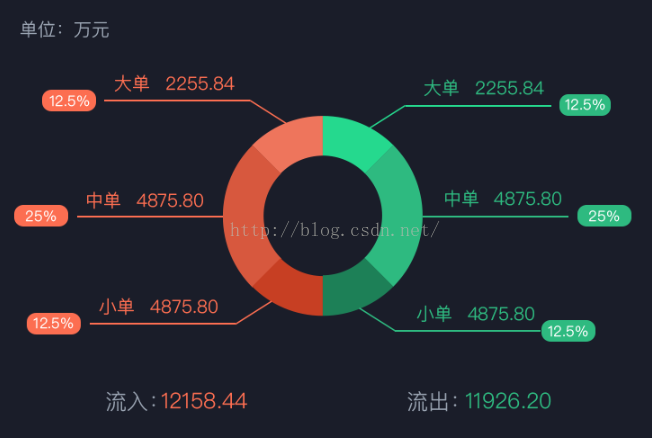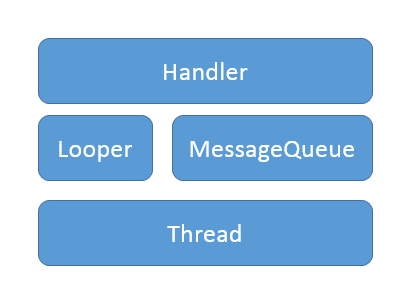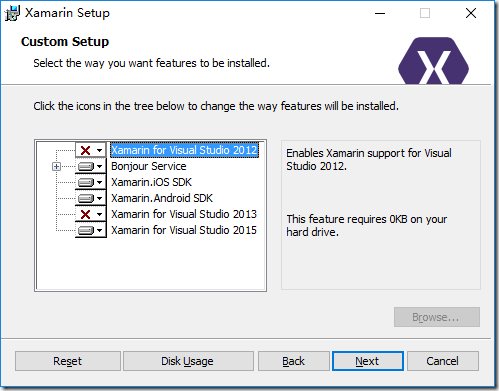編輯:關於Android編程
單位項目要實現如下圖這種環形圖或是說特殊的餅形圖,在網上找了半天,沒有發現開源的,沒法子,只能硬著頭皮自己寫一個了。最近也在學習自定義view。正好拿這個來進行練習一下。

先分析一下功能,
1, 一共六個環形,每個顏色,弧度不同,
2, 在每個環形上,根據其環的弧度不同,在弧的中心點上,伸出線,在線上顯示相應的數值
3, 在線的結尾處,顯示一個圓角方形,內部是其百分比。
一,六個環形的畫法
一般在畫環形時,我們都是采用畫圈,然後設置其style為空心,給StrokeWidth一個值,用它來設置環的寬,可是這裡有一個問題,在設置完寬之後,它的這個寬是在邊為1的情況下,向內外擴展。說簡單一點,就是如果我們要畫一個半徑為100的環,如果你把StrokeWidth設成20,你會發現,最後畫出來的,是一個半徑為110的環。在這種情況下,我們在畫環上線的時候,算其長度會有麻煩。
我采用了一個比較笨的方法,就是畫一個實心圓,然後再畫一個半徑減去環寬的小圓,這樣就達到了圓環的效果。這樣還有一個好處是,中心的圓的顏色也可以自定義了。
這裡其實最麻煩的是算環形的半徑,這裡我一直也沒有想好有什麼太好的方法,我的方法比較笨,就是取控件的高度一半,然後再減去一個值,因為我認為,這個控件是一個寬大於高的控件,因為左右會有伸出的線嗎,所以相當來說,高就是比較小的哪個值,只所以還要減一個值,是因為要給線上的值,留一個空位出來,看一下效果圖,就明白什麼意思了。
二,環上的線
這裡我采用了三角函數進行計算弧的中心點,然後根據它的不同位置進行畫線,這裡無非就是八種情況,向右上折,向右全直,向右下折,垂直向下然後右直,重直向下左直,向左上折,向左全直,向左下折。而直線的長度,我是根據線上的文字的長度來確定,然後左右各留出10的寬度.
三,在線尾處畫圓角方形和百分比
前兩步做完,這一步就比較簡單了,采用drawRoundRect就可以很輕松的完成。
好了,分析到此為止,下面是代碼,裡面的注解比較清楚。
package com.example.cg.customcirclepre.custom;
import android.content.Context;
import android.content.res.TypedArray;
import android.graphics.Canvas;
import android.graphics.Color;
import android.graphics.Paint;
import android.graphics.Rect;
import android.graphics.RectF;
import android.util.AttributeSet;
import android.util.TypedValue;
import android.view.View;
import com.example.cg.customcirclepre.R;
import java.text.DecimalFormat;
/**
* 帶動畫的自定義餅形圖
* 作者:cg
* 時間:2016/9/6 0006 下午 2:48
*/
public class AnimationCirPre extends View {
private float iBNum = 150; //流入大單數
private int iBColor = Color.parseColor("#EE755C"); //流入大單顏色
private float iMNum = 200; //流入中單數
private int iMColor = Color.parseColor("#D7583E"); //流入中單顏色
private float iSNum = 180; //流入小單數
private int iSColor = Color.parseColor("#C73F23"); //流入小單顏色
private float oBNum = 660; //流出大單數
private int oBColor = Color.parseColor("#25D98E"); //流出大單顏色
private float oMNum = 210; //流出中單數
private int oMColor = Color.parseColor("#2EBA80"); //流出中單顏色
private float oSNum = 195; //流出小單數
private int oSColor = Color.parseColor("#1D8057"); //流出小單顏色
private int StrokeWidth = 150; //弧的寬度
private int TextSize = 50; //文字大小
private boolean isAnimation = false; //是否使用動畫效果
private int AnimationSpeed = 2; //動畫的速度
private int circleCenterColor = Color.parseColor("#ffffff"); //圓心顏色,默認是白色
private Paint mPaint; //畫筆
private RectF mRectf; //外圈圓的方形
private Rect mBound; //文字外框
private String txtNumPre; //顯示所占百分比
float[] point; //記錄弧度最外邊中心點的坐標
private int adjustDist = 20; //在弧度上面的線,為了調整其最好的顯示位置設置一個調整的距離數
private float txtBeginX = 0; //線上文字開始的位置的X坐標值
private float txtBeginY = 0; //線上文字開始的位置的y坐標值
private float txtEndX =0; //線上文字結束的位置的x坐標值
//計算總數
private float sum;
//計算六個值的百分比
private float oBpre;
private float oMpre;
private float oSpre;
private float iBpre;
private float iMpre;
private float iSpre;
//計算六個值所占圓的弧度數
private float oBArc;
private float oMArc;
private float oSArc;
private float iBArc;
private float iMArc;
private float iSArc;
//六個值弧度的初始值
private float mOBArc = 1;
private float mOMArc = 1;
private float mOSArc = 1;
private float mISArc = 1;
private float mIMArc = 1;
private float mIBArc = 1;
public AnimationCirPre(Context context) {
this(context,null);
}
public AnimationCirPre(Context context, AttributeSet attrs) {
this(context, attrs,0);
}
public AnimationCirPre(Context context, AttributeSet attrs, int defStyleAttr) {
super(context, attrs, defStyleAttr);
TypedArray array = getContext().getTheme().obtainStyledAttributes(attrs, R.styleable.MyPre, defStyleAttr, 0);
int n = array.getIndexCount();
for(int i=0;i= oBArc) {
DrawOB(canvas, radius, oBArc, oBpre);
mPaint.setColor(oMColor);
canvas.drawArc(mRectf, 270 + oBArc, mOMArc, true, mPaint);
mOMArc = mOMArc + AnimationSpeed;
if (mOMArc <= oMArc) {
postInvalidate();
}
}
//第三個
if (mOMArc >= oMArc) {
DrawOM(canvas, radius, oBArc, oMArc, oMpre);
mPaint.setColor(oSColor);
canvas.drawArc(mRectf, 270 + oBArc + oMArc, mOSArc, true, mPaint);
mOSArc = mOSArc + AnimationSpeed;
if (mOSArc <= oSArc) {
postInvalidate();
}
}
//第四個
if (mOSArc >= oSArc) {
DrawOS(canvas, radius, oBArc + oMArc, oSArc, oSpre);
mPaint.setColor(iSColor);
canvas.drawArc(mRectf, 270 + oBArc + oMArc + oSArc, mISArc, true, mPaint);
mISArc = mISArc + AnimationSpeed;
if (mISArc <= iSArc) {
postInvalidate();
}
}
//第五個
if (mISArc >= iSArc) {
DrawIS(canvas, radius, oBArc + oMArc + oSArc, iSArc, iSpre);
mPaint.setColor(iMColor);
canvas.drawArc(mRectf, 270 + oBArc + oMArc + oSArc + iSArc, mIMArc, true, mPaint);
mIMArc = mIMArc + AnimationSpeed;
if (mIMArc <= iMArc) {
postInvalidate();
}
}
//第六個
if (mIMArc >= iMArc ) {
DrawIM(canvas, radius, oBArc + oMArc + oSArc + iSArc, iMArc, iMpre);
mPaint.setColor(iBColor);
canvas.drawArc(mRectf, 270 + oBArc + oMArc + oSArc + iSArc + iMArc, mIBArc, true, mPaint);
mIBArc = mIBArc + AnimationSpeed;
if (mIBArc <= iBArc + 1) {
postInvalidate();
}
}
if (mIBArc >= iBArc) {
DrawIB(canvas, radius, oBArc + oMArc + oSArc + iSArc + iMArc, iBArc, iBpre);
}
}else {
/**
* 畫出六個扇面
*/
mPaint.setColor(oBColor);
canvas.drawArc(mRectf, 270, oBArc, true, mPaint);
mPaint.setColor(oMColor);
canvas.drawArc(mRectf, 270 + oBArc, oMArc, true, mPaint);
mPaint.setColor(oSColor);
canvas.drawArc(mRectf, 270 + oBArc + oMArc, oSArc, true, mPaint);
mPaint.setColor(iSColor);
canvas.drawArc(mRectf, 270 + oBArc + oMArc + oSArc, iSArc, true, mPaint);
mPaint.setColor(iMColor);
canvas.drawArc(mRectf, 270 + oBArc + oMArc + oSArc + iSArc, iMArc, true, mPaint);
mPaint.setColor(iBColor);
canvas.drawArc(mRectf, 270 + oBArc + oMArc + oSArc + iSArc + iMArc, iBArc, true, mPaint);
DrawOB(canvas, radius, oBArc, oBpre);
DrawOM(canvas, radius, oBArc, oMArc, oMpre);
DrawOS(canvas, radius, oBArc + oMArc, oSArc, oSpre);
DrawIS(canvas, radius, oBArc + oMArc + oSArc, iSArc, iSpre);
DrawIM(canvas, radius, oBArc + oMArc + oSArc + iSArc, iMArc, iMpre);
DrawIB(canvas, radius, oBArc + oMArc + oSArc + iSArc + iMArc, iBArc, iBpre);
}
/**
* 畫出中間的空白區域
*/
mPaint.setColor(circleCenterColor);
canvas.drawCircle(getWidth() / 2, getHeight() / 2, radius - StrokeWidth, mPaint);
}
/**
* 流出大單
* @param canvas 畫板
* @param radius 中心半徑
* @param oBArc 流出大單弧度
* @param oBpre 流出大單百分比
*/
public void DrawOB(Canvas canvas,float radius,float oBArc,float oBpre)
{
/**
* 流出大單
*/
if(oBNum>0)
{
//設置顯示的大單數量,在橫線上顯示的文字
mPaint.setColor(oBColor);
mPaint.setTextSize(TextSize);
String txt = "大單 " + oBNum;
mPaint.getTextBounds(txt, 0, txt.length(), mBound);
//計算弧度的中心點
point = new float[2];
point[0] = (float)(radius * Math.cos(Math.PI * (Math.abs(90 - oBArc / 2)) / 180));
point[1] = (float)(radius * Math.sin(Math.PI * (Math.abs(90 - oBArc / 2)) / 180));
/**
* 右側第一個弧度,無論為何值,它都不會在左半球,出現折線,所以它有四種情況
* 1,弧度小於160時,它的中心線在90度以上,只所以沒有取180,是因為中間要留出20度,給直線,所以它有一個向上的折線。
* 2,弧度小於等於200時,因為是一個else語句,所以它的中心點范圍是80--100,是一條直線。
* 3,弧度小於340時,因為是一個else語句,所以它的中心點范圍是 100-170,是一條向下的折線。
* 4,弧度小於360時,因為是一個else語句,所以它的中心點范圍是 170-180,它是一條向下垂直的線
*/
//畫弧上的線
drawLine(canvas, oBArc / 2, radius, 1);
canvas.drawText(txt, txtEndX - mBound.width() - adjustDist / 2, txtBeginY - adjustDist / 2, mPaint);
//畫線後的橢圓
txtNumPre = getProValText(oBpre);
mPaint.getTextBounds(txtNumPre, 0, txtNumPre.length(), mBound);
mPaint.setStyle(Paint.Style.FILL);
canvas.drawRoundRect(txtEndX + 10,
txtBeginY - mBound.height() / 2 - adjustDist/2,
txtEndX + adjustDist/2 + mBound.width() + 30,
txtBeginY - mBound.height() / 2 + mBound.height() + adjustDist/2,
15, 15, mPaint);
mPaint.setColor(Color.parseColor("#ffffff"));
canvas.drawText(txtNumPre, txtEndX + adjustDist / 2 + adjustDist / 2, txtBeginY + mBound.height() / 2, mPaint);
}
}
/**
* 流出中單
* @param canvas 畫板
* @param radius 中心半徑
* @param oBArc 流出大單弧度
* @param oMArc 流出中單弧度
* @param oMpre 流出中單百分比
*/
public void DrawOM(Canvas canvas,float radius,float oBArc,float oMArc,float oMpre)
{
if(oMNum>0)
{
mPaint.setColor(oMColor);
mPaint.setTextSize(TextSize);
String txt = "中單 " + oMNum;
mPaint.getTextBounds(txt, 0, txt.length(), mBound);
point = new float[2];
point[0] = (float)(radius * Math.cos(Math.PI * (Math.abs(90 - (oMArc / 2 + oBArc))) / 180));
point[1] = (float)(radius * Math.sin(Math.PI * (Math.abs(90 - (oMArc/2 + oBArc)))/180));
/**
* 右側第二個弧度,所以它有七種情況,它的情況與第一個弧度有關,所以它的弧度值要與第一個弧度進行相加來處理
* 第一個弧度加上本身弧度的一半,可以得到中心點的位置,根據中心的位置進行判斷其位置
* 1,弧度中心點小於80時,它的中心線在90度以上,只所以沒有取180,是因為中間要留出20度,給直線,所以它有一個向上的折線。
* 2,弧度中心點小於等於100時,因為是一個else語句,所以它的中心點范圍是80--100,是一條直線。
* 3,弧度中心點小於170時,因為是一個else語句,所以它的中心點范圍是 100-170,是一條向下的折線。
* 4,弧度中心點小於180時,因為是一個else語句,所以它的中心點范圍是 170-180,它是一條向下垂直的線
* 5,弧度中心點小於260時,因為是一個else語句,所以它會在左邊生成一個向下拆的線
* 6,弧度中心點小於280時,因為是一個else語句,它會在左邊中間的位置生下一條直線
* 7,弧度中心點於小360時,因為是一個else語句,它會在左邊上部,生成一個向上有折線的線
*/
float oMCenterArc = oBArc + oMArc/2;
//畫弧上的線
drawLine(canvas, oMCenterArc, radius, 1);
//畫出線上數據與後面橢圓型的百分比
drawRect(canvas, txt, oMpre, oMCenterArc,1);
}
}
/**
* 流出小單
* @param canvas 畫板
* @param radius 中心半徑
* @param oBMArc 流出大單和中單弧度和
* @param oSArc 流出小單弧度
* @param oSpre 流出小單百分比
*/
public void DrawOS(Canvas canvas,float radius,float oBMArc,float oSArc,float oSpre)
{
if(oSNum>0)
{
mPaint.setColor(oSColor);
mPaint.setTextSize(TextSize);
String txt = "小單 " + oSNum;
mPaint.getTextBounds(txt, 0, txt.length(), mBound);
point = new float[2];
point[0] = (float)(radius * Math.cos(Math.PI * (Math.abs(90 - (oSArc / 2 + oBMArc))) / 180));
point[1] = (float)(radius * Math.sin(Math.PI * (Math.abs(90 - (oSArc/2 + oBMArc)))/180));
float oMCenterArc = oBMArc + oSArc/2;
//畫弧上的線
drawLine(canvas,oMCenterArc,radius,1);
drawRect(canvas,txt,oSpre,oMCenterArc,1);
}
}
/**
* 流入小單
* @param canvas 畫板
* @param radius 中心半徑
* @param oBMSArc 流出大單,中單,小單弧度和
* @param iSArc 流入小單弧度
* @param iSpre 流入小單百分比
*/
public void DrawIS(Canvas canvas,float radius,float oBMSArc,float iSArc,float iSpre)
{
if(iSNum>0)
{
mPaint.setColor(iSColor);
mPaint.setTextSize(TextSize);
String txt = "小單 " + iSNum;
mPaint.getTextBounds(txt, 0, txt.length(), mBound);
point = new float[2];
point[0] = (float)(radius * Math.cos(Math.PI * (Math.abs(90 - (iSArc / 2 + oBMSArc))) / 180));
point[1] = (float)(radius * Math.sin(Math.PI * (Math.abs(90 - (iSArc / 2 + oBMSArc))) / 180));
float oMCenterArc = oBMSArc + iSArc/2;
//畫弧上的線
drawLine(canvas,oMCenterArc,radius,2);
//畫出線上數據與後面橢圓型的百分比
drawRect(canvas,txt,iSpre,oMCenterArc,2);
}
}
/**
* 流入中單
* @param canvas 畫板
* @param radius 中心半徑
* @param oBMSiMArc 流出大單,中單,小單,流入小單弧度和
* @param iMArc 流入中單弧度
* @param iMpre 流入中單百分比
*/
public void DrawIM(Canvas canvas,float radius,float oBMSiMArc,float iMArc,float iMpre)
{
if(iMNum>0)
{
mPaint.setColor(iSColor);
mPaint.setTextSize(TextSize);
String txt = "中單 " + iMNum;
mPaint.getTextBounds(txt, 0, txt.length(), mBound);
point = new float[2];
point[0] = (float)(radius * Math.cos(Math.PI * (Math.abs(90 - (iMArc / 2 + oBMSiMArc))) / 180));
point[1] = (float)(radius * Math.sin(Math.PI * (Math.abs(90 - (iMArc/2 + oBMSiMArc)))/180));
float oMCenterArc = oBMSiMArc + iMArc/2;
//畫弧上的線
drawLine(canvas, oMCenterArc, radius,2);
//畫出線上數據與後面橢圓型的百分比
drawRect(canvas,txt,iMpre,oMCenterArc,2);
}
}
/**
* 流入大單
* @param canvas 畫板
* @param radius 中心半徑
* @param oBMSiSMArc 流出大單,中單,小單,流入小單,中單弧度和
* @param iBArc 流入大單弧度
* @param iBpre 流入大單百分比
*/
public void DrawIB(Canvas canvas,float radius,float oBMSiSMArc,float iBArc,float iBpre)
{
if(iMNum>0)
{
mPaint.setColor(iSColor);
mPaint.setTextSize(TextSize);
String txt = "大單 " + iBNum;
mPaint.getTextBounds(txt, 0, txt.length(), mBound);
point = new float[2];
point[0] = (float)(radius * Math.cos(Math.PI * (Math.abs(90 - (iBArc / 2 + oBMSiSMArc))) / 180));
point[1] = (float)(radius * Math.sin(Math.PI * (Math.abs(90 - (iBArc/2 + oBMSiSMArc)))/180));
float oMCenterArc = oBMSiSMArc + iBArc/2;
//畫弧上的線
drawLine(canvas,oMCenterArc,radius,2);
//畫出線上數據與後面橢圓型的百分比
drawRect(canvas,txt,iBpre,oMCenterArc,2);
}
}
/**
* 根據弧度值,來畫出弧度中心點伸出的線
* @param canvas 畫板
* @param sumArc 弧度之和
* @param radius 中心半徑
* @param flag 標識位,1:左側流出單 2:右側注入單
*/
public void drawLine(Canvas canvas,float sumArc,float radius,int flag)
{
if(sumArc <= 80)
{
draw80(canvas);
}else if(sumArc <=100) {
draw100(canvas,sumArc);
}else if(sumArc <=170){
draw170(canvas);
}else if(sumArc <=190)
{
draw180(canvas,radius,flag);
}else if(sumArc <=260) {
draw260(canvas);
}
else if(sumArc <=290) {
draw280(canvas);
}else
{
draw360(canvas);
}
}
/**
* 畫出弧度中心點小於80弧度的上面的線與值
* 這裡的弧度中心點小於80,是它前面的所有弧度加上它本身的總度數的一半,如果是第一個弧,則為其本身的一半,此處畫出的是左側80度以下,帶有向上折線的兩根線
* @param canvas 畫板
*/
public void draw80(Canvas canvas)
{
txtBeginX = getWidth()/2 + point[0] + 40;
txtBeginY = getHeight()/2 - point[1] - 20;
canvas.drawLine(getWidth()/2 + point[0],
getHeight()/2 - point[1],
txtBeginX,
txtBeginY,mPaint);
txtEndX = txtBeginX + mBound.width() + 20;
canvas.drawLine(txtBeginX,txtBeginY,
txtEndX,txtBeginY,mPaint);
}
/**
* 畫出弧度中心點大於等於80小於等於100弧度上面的線與值
* 這裡的弧度中心點大於等於80小於等於100,是它前面的所有弧度加上它本身的總度數的一半,如果是第一個弧,則為其本身的一半,此處畫出的是左側80-100度之間,一根直線
* @param canvas 畫板
* @param sumArc 當前總弧度,當弧度大於90度時,其Y軸起始點應該向下移
*/
public void draw100(Canvas canvas,float sumArc)
{
txtBeginX = getWidth() / 2 + point[0];
if(sumArc>90)
{
txtBeginY = getHeight() / 2 + point[1];
}else {
txtBeginY = getHeight() / 2 - point[1];
}
txtEndX = txtBeginX + mBound.width() + adjustDist;
canvas.drawLine(txtBeginX, txtBeginY,
txtEndX, txtBeginY, mPaint);
}
/**
* 畫出弧度中心點大於100小於170弧度上面的線與值
* 這裡的弧度中心點大於100小於170,是它前面的所有弧度加上它本身的總度數的一半,如果是第一個弧,則為其本身的一半,此處畫出的是左側100-170度之間,帶有向下折線的兩根線
* @param canvas 畫板
*/
public void draw170(Canvas canvas)
{
txtBeginX = getWidth()/2 + point[0] + adjustDist*2;
txtBeginY = getHeight()/2 + point[1] + adjustDist;
canvas.drawLine(getWidth()/2 + point[0],
getHeight()/2 + point[1],
txtBeginX,
txtBeginY, mPaint);
txtEndX = txtBeginX + mBound.width() + adjustDist;
canvas.drawLine(txtBeginX, txtBeginY,
txtEndX, txtBeginY, mPaint);
}
/**
* 畫出弧度中心點大於170小於190弧度上面的線與值
* 這裡的弧度中心點大於170小於190,是它前面的所有弧度加上它本身的總度數的一半,如果是第一個弧,則為其本身的一半,此處畫出的是左側170-190度之間,帶有垂直向下折線的兩根線
* @param canvas 畫板
* @param radius 半徑
* @param flag 標識位 1:右側流出量 2:左側流入量
*/
public void draw180(Canvas canvas,float radius,int flag)
{
txtBeginX = getWidth() / 2 + point[0];
txtBeginY = getHeight() / 2 + point[1] + adjustDist;
canvas.drawLine(getWidth() / 2 + point[0],
getHeight() / 2 + point[1],
txtBeginX,
txtBeginY, mPaint);
//此處加一個判斷,主要是當在最下面畫線的時候,流出向右畫線,流入向左畫線
if(flag==1) {
txtEndX = txtBeginX + radius / 2 + mBound.width() + adjustDist;
}else{
txtEndX = txtBeginX - radius / 2 - mBound.width() - adjustDist;
}
canvas.drawLine(txtBeginX, txtBeginY,
txtEndX, txtBeginY, mPaint);
}
/**
* 畫出弧度中心點大於190,小於260弧度上面的線與值
* 這裡的弧度中心點大於190小於260,是它前面的所有弧度加上它本身的總度數的一半,此處畫出的是左側190-260度之間,右邊帶有垂直向下折線的兩根線
* @param canvas 畫板
*/
public void draw260(Canvas canvas)
{
txtBeginX = getWidth() / 2 + point[0] - 40;
txtBeginY = getHeight() / 2 + point[1] + 20;
canvas.drawLine(getWidth() / 2 + point[0],
getHeight() / 2 + point[1],
txtBeginX,
txtBeginY, mPaint);
txtEndX = txtBeginX - mBound.width() - 20;
canvas.drawLine(txtBeginX, txtBeginY,
txtEndX, txtBeginY, mPaint);
}
/**
* 畫出弧度中心點大於260,小於280弧度上面的線與值
* 這裡的弧度中心點大於260小於280,是它前面的所有弧度加上它本身的總度數的一半,此處畫出的是左側260-280度之間,右邊的一根直線
* @param canvas 畫板
*/
public void draw280(Canvas canvas)
{
txtBeginX = getWidth() / 2 + point[0];
txtBeginY = getHeight() / 2 + point[1];
txtEndX = txtBeginX - mBound.width() - 20;
canvas.drawLine(txtBeginX, txtBeginY,
txtEndX, txtBeginY, mPaint);
}
/**
* 畫出弧度中心點大於280,小於360弧度上面的線與值
* 這裡的弧度中心點大於280小於360,是它前面的所有弧度加上它本身的總度數的一半,此處畫出的是左側280-360度之間,右邊向上折的兩根直線
* @param canvas 畫板
*/
public void draw360(Canvas canvas)
{
txtBeginX = getWidth()/2 + point[0] - 40;
txtBeginY = getHeight()/2 + point[1] - 20;
canvas.drawLine(getWidth() / 2 + point[0],
getHeight() / 2 + point[1],
txtBeginX,
txtBeginY, mPaint);
txtEndX = txtBeginX - mBound.width() - 20;
canvas.drawLine(txtBeginX, txtBeginY,
txtEndX, txtBeginY, mPaint);
}
/**
* 畫線上的文字與後面橢圓型的百分比
* @param canvas 畫板
* @param txt 線上文字
* @param iBpre 百分比
* @param oMCenterArc 弧度數
* @param flag 標識位 1: 右邊流出量 2: 左邊流入量
*/
public void drawRect(Canvas canvas,String txt,float iBpre,float oMCenterArc,int flag)
{
if(oMCenterArc >=80 && oMCenterArc <=100)
{
draw100Rect(canvas,txt,iBpre);
}
else if(oMCenterArc<=190) {
draw190Rect(canvas,txt,iBpre,flag,oMCenterArc);
}else
{
drawOtherRect(canvas,txt,iBpre);
}
}
/**
* 處了右側第一個弧度外。當前弧度的一半加上之前弧度的和,在80-100之間,畫出線上文字與之後的百分比
* @param canvas 畫板
* @param txt 線上文字
* @param oMpre 百分比
*/
public void draw100Rect(Canvas canvas,String txt,float oMpre)
{
canvas.drawText(txt, txtBeginX + 10, txtBeginY - 10, mPaint);
//畫線後的橢圓
txtNumPre = getProValText(oMpre);
mPaint.getTextBounds(txtNumPre, 0, txtNumPre.length(), mBound);
mPaint.setStyle(Paint.Style.FILL);
canvas.drawRoundRect(txtEndX + 10,
txtBeginY - mBound.height() / 2 - 10,
txtEndX + 10 + mBound.width() + 30,
txtBeginY - mBound.height() / 2 + mBound.height() + 10,
15, 15, mPaint);
mPaint.setColor(Color.parseColor("#ffffff"));
canvas.drawText(txtNumPre, txtEndX + 10 + 10, txtBeginY + mBound.height() / 2, mPaint);
}
/**
* 處了右側第一個弧度外。當前弧度的一半加上之前弧度的和,在小於等於190,並且不包括80-100的數據,畫出線上文字與之後的百分比
* @param canvas 畫板
* @param txt 線上文字
* @param oMpre 百分比
* @param flag 標識位 1:右側流出 2:左側流入
* @param oMArc 弧度之和
*/
public void draw190Rect(Canvas canvas,String txt,float oMpre,int flag,float oMArc)
{
//左側的流入三個弧度,如果在正下方,則特殊處理
if(flag==2 && (oMArc>=170 && oMArc <=190))
{
canvas.drawText(txt, txtEndX + 20, txtBeginY - 10, mPaint);
//畫線後的橢圓
txtNumPre = getProValText(oMpre);
mPaint.getTextBounds(txtNumPre, 0, txtNumPre.length(), mBound);
mPaint.setStyle(Paint.Style.FILL);
canvas.drawRoundRect(txtEndX - 10 - 10 - mBound.width() - 10 ,
txtBeginY - mBound.height() / 2 - 10,
txtEndX - 10,
txtBeginY - mBound.height() / 2 + mBound.height() + 10,
15, 15, mPaint);
mPaint.setColor(Color.parseColor("#ffffff"));
canvas.drawText(txtNumPre, txtEndX - 10 - 10 - mBound.width(), txtBeginY + mBound.height() / 2, mPaint);
}else {
canvas.drawText(txt, txtEndX - mBound.width() - 20, txtBeginY - 10, mPaint);
//畫線後的橢圓
txtNumPre = getProValText(oMpre);
mPaint.getTextBounds(txtNumPre, 0, txtNumPre.length(), mBound);
mPaint.setStyle(Paint.Style.FILL);
canvas.drawRoundRect(txtEndX + 10,
txtBeginY - mBound.height() / 2 - 10,
txtEndX + 20 + mBound.width() + 20,
txtBeginY - mBound.height() / 2 + mBound.height() + 10,
15, 15, mPaint);
mPaint.setColor(Color.parseColor("#ffffff"));
canvas.drawText(txtNumPre, txtEndX + 20, txtBeginY + mBound.height() / 2, mPaint);
}
}
/**
* 處了右側第一個弧度外。當前弧度的一半加上之前弧度的和,在大於190,畫出線上文字與之後的百分比
* @param canvas 畫板
* @param txt 線上文字
* @param oMpre 百分比
*/
public void drawOtherRect(Canvas canvas,String txt,float oMpre)
{
canvas.drawText(txt, txtEndX + 10, txtBeginY - 10, mPaint);
//畫線後的橢圓
txtNumPre = getProValText(oMpre);
mPaint.getTextBounds(txtNumPre, 0, txtNumPre.length(), mBound);
mPaint.setStyle(Paint.Style.FILL);
canvas.drawRoundRect(txtEndX - 10 - mBound.width() - 30,
txtBeginY - mBound.height() / 2 - 10,
txtEndX - 10,
txtBeginY - mBound.height() / 2 + mBound.height() + 10,
15, 15, mPaint);
mPaint.setColor(Color.parseColor("#ffffff"));
canvas.drawText(txtNumPre, txtEndX - 10 - mBound.width() - 30 + 10, txtBeginY + mBound.height() / 2, mPaint);
}
/**
* 格式化顯示的百分比
* @param proValue 傳入的數值一般是0.1234這種格式的
* @return 返回一個小數點後一位的百分比字符串
*/
private String getProValText(float proValue)
{
DecimalFormat format = new DecimalFormat("#0.0");
return format.format(proValue * 100) + "%";
}
public void setNum(float oBNum,float oMNum, float oSNum,float iBNum,float iMNum,float iSNum)
{
this.oBNum = oBNum;
this.oMNum = oMNum;
this.oSNum = oSNum;
this.iBNum = iBNum;
this.iMNum = iMNum;
this.iSNum = iSNum;
//計算總數
sum = oBNum + oMNum + oSNum + iBNum + iMNum + iSNum;
//計算六個值的百分比
oBpre = oBNum / sum;
oMpre = oMNum / sum;
oSpre = oSNum / sum;
iBpre = iBNum / sum;
iMpre = iMNum / sum;
iSpre = iSNum / sum;
//計算六個值所占圓的弧度數
oBArc = oBpre * 360;
oMArc = oMpre * 360;
oSArc = oSpre * 360;
iBArc = iBpre * 360;
iMArc = iMpre * 360;
iSArc = iSpre * 360;
mOBArc = 1;
mOMArc = 1;
mOSArc = 1;
mISArc = 1;
mIMArc = 1;
mIBArc = 1;
postInvalidate();
}
}
//自定義屬性名,定義公共屬性 //自定義控件的主題樣式
AnimationCirPre.java 添加了動畫效果。
 詳解Android中Handler的內部實現原理
詳解Android中Handler的內部實現原理
本文主要是對Handler和消息循環的實現原理進行源碼分析,如果不熟悉Handler可以參見博文《詳解Android中Handler的使用方法》,裡面對Android為何
 08_android入門_android-async-http開源項目介紹及使用方法
08_android入門_android-async-http開源項目介紹及使用方法
android-async-http開源項目可以是我們輕松的獲取網絡數據或者向服務器發送數據,使用起來非常簡單,關於android-async-http開源項目的介紹內容
 Android仿微信發表說說實現拍照、多圖上傳功能
Android仿微信發表說說實現拍照、多圖上傳功能
本文實例為大家分享了Android仿微信發表說說、心情功能,供大家參考,具體內容如下既能實現拍照,選圖庫,多圖案上傳的案例,目前好多App都有類似微信朋友圈的功能,能過發
 Android將Xamarin For VS升級為4.1.0.530版教程
Android將Xamarin For VS升級為4.1.0.530版教程
一、Xamarin for VS的版本簡介下面是Xamarin for VS發布的版本簡介:……更早的版本(略)2015年11月發布:Xamarin for VS 4.0